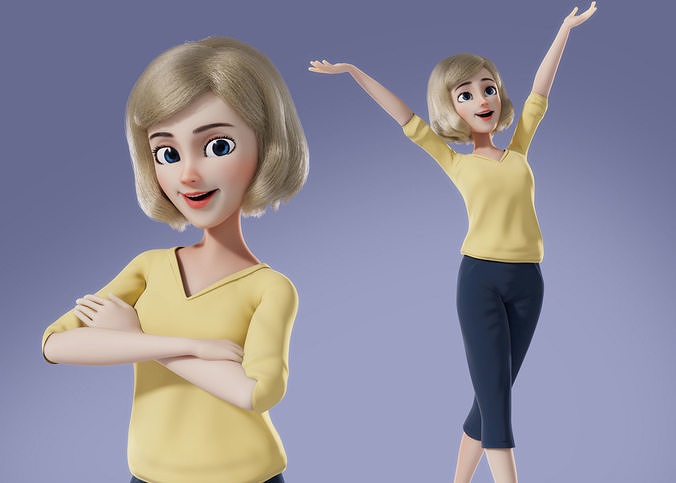In today's ever-evolving digital domain, technology stands as a beacon of transformation, especially evident in the realm of rigged 3D character models. These digital avatars have become indispensable across diverse industries, from gaming to animation and virtual reality.
The enthralling world of digital entertainment and immersive experiences has undergone a profound metamorphosis, driven by remarkable technological innovations, particularly in 3D modeling and animation. As we embark on an exploration of virtual reality, augmented reality, and cutting-edge gaming experiences, the demand for lifelike digital characters has surged. Enter the captivating realm of rigged 3D character models – a fusion of artistic expression and technological mastery that blurs the lines between reality and fantasy.
This comprehensive article delves into the fascinating realm of rigged 3D character models, elucidating their significance, evolution, and the technological marvels that breathe life into them.
The Genesis of Rigged 3D Character Models:
Rigged 3D character models signify a monumental leap forward in digital design, empowering artists to infuse vitality into their creations. Unlike static models, rigged characters boast an internal framework, or skeleton, enabling realistic movement and expressions. This groundbreaking technology stems from the demand for more immersive and dynamic visual experiences.
The Anatomy of Rigged 3D Models:
At the heart of these models lies a sophisticated skeletal structure governed by a network of digital joints and bones. This skeletal framework mirrors human anatomy, facilitating a spectrum of movements manipulated by animators. Meticulously crafted muscles, joints, and facial features form a virtual puppetry system responsive to animator commands.
Artistic Fusion with Technology: The Animation Process:
The symbiosis of artistry and technology manifests vividly in the animation process of rigged 3D character models. Animators harness specialized software to manipulate the model's skeleton, fashioning lifelike movements that resonate with audiences. This intricate process necessitates a deep comprehension of both artistic expression and the technical intricacies of digital animation.
Applications Across Industries:
Rigged 3D character models transcend the confines of animation studios, finding utility across a diverse array of industries. In the realm of gaming, these models enrich user experiences by animating protagonists and antagonists, enabling gamers to engage in a dynamic and responsive virtual environment. Similarly, sectors such as virtual reality and augmented reality leverage rigged models to fabricate immersive simulations.
The Evolution of Rigged Models: From Stiff to Fluid Movements:
Technological strides have played a pivotal role in the evolution of rigged 3D character models. Early iterations exhibited somewhat rigid movements, constrained by processing 0power and software limitations. However, with the advent of potent hardware and sophisticated algorithms, characters now move with fluidity, blurring the demarcation between the virtual and the real.
Challenges and Innovations: Navigating the Uncanny Valley:
Despite remarkable progress in perfecting rigged 3D character models, challenges persist, notably in surmounting the "uncanny valley" phenomenon. This phenomenon denotes the disconcerting sensation evoked by characters that are almost, but not quite, human. Ongoing innovations in facial recognition technology and animation algorithms endeavor to bridge this gap, edging us closer to seamlessly realistic virtual characters.
The Future: Beyond Animation and Gaming:
As technology advances unabatedly, the horizon of rigged 3D character models brims with boundless potentialities. Beyond the realms of animation and gaming, industries spanning education, healthcare, and marketing are exploring avenues to harness these digital avatars. Virtual classrooms with interactive instructors, medical simulations for training healthcare practitioners, and personalized marketing experiences represent a mere glimpse of the transformative capacities these models harbor.
Advantages and Disadvantages:
A notable advantage lies in the accessibility of creating 3D models, even for individuals unfamiliar with photogrammetry. While technical expertise is requisite, the process becomes smooth and user-friendly upon installation. Converting video into images proves seamless, aided by provided Python scripts. Once these assets are established, integration with artificial intelligence ensues seamlessly.
Conclusion
In conclusion, the deep dive into rigged 3D character modeling unveils a digital odyssey wherein technology and creativity converge harmoniously. From humble origins to their pervasive applications today, these models epitomize human ingenuity and our perpetual quest to transcend the limits of the digital realm. As technology marches onward, so too will the capabilities of rigged 3D character models, heralding an exhilarating future where the boundaries between reality and the virtual domain continue to blur.
Frequently Asked Questions:
-
What sets rigged 3D character models apart from traditional static models?
Rigged 3D character models distinguish themselves by incorporating an internal skeletal structure, enabling realistic movements and expressions. Unlike static models, rigged characters are dynamic and amenable to animation for a more immersive visual experience.
-
How do animators manipulate the skeletal structure of rigged 3D character models?
Animators leverage specialized software to manipulate the digital joints and bones within the model's skeletal structure. This entails crafting lifelike movements, encompassing facial expressions and bodily gestures, to breathe life into the character.
-
In which industries are rigged 3D character models commonly used?
Rigged 3D character models find utility across diverse industries, including animation, gaming, virtual reality, augmented reality, education, healthcare, and marketing. Their versatility renders them invaluable assets in crafting interactive and captivating experiences.
-
What is the "uncanny valley" phenomenon, and how do rigged 3D character models address it?
The "uncanny valley" denotes the unsettling feeling experienced when a character appears almost human but falls short of being convincingly realistic. Rigged 3D character models tackle this phenomenon by leveraging advancements in facial recognition technology and animation algorithms to create more authentic and less eerie virtual characters.
-
How have technological advancements influenced the evolution of rigged 3D character models?
Technological progress, including the advent of potent hardware and sophisticated algorithms, has played a pivotal role in shaping the evolution of rigged 3D character models. These advancements have culminated in characters exhibiting more fluid and realistic movements, pushing the boundaries of digital animation.


No comments yet